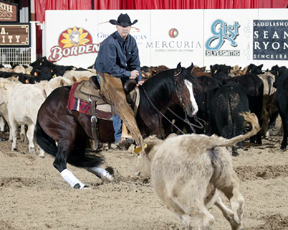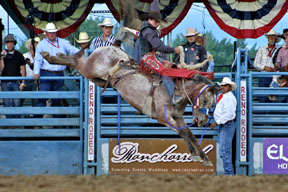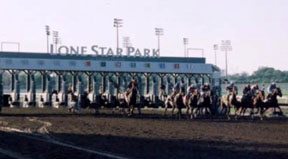NCHA Futurity Set to Open Monday:
 FORT WORTH, (NCHA) – The National Cutting Horse Association’s most widely-anticipated event of the year, the 2011 Borden Milk/NCHA World
FORT WORTH, (NCHA) – The National Cutting Horse Association’s most widely-anticipated event of the year, the 2011 Borden Milk/NCHA World
Championship Futurity 50, is set to begin its 20-day run on Nov. 21, boasting 1,600 entries and a purse nearing $4 million.
The annual NCHA Triple Crown series begins with the Borden Milk Futurity and continues with the XTO Energy Super Stakes in April, followed by the Great American Insurance Summer Cutting Spectacular in July. All three events are held at Will Rogers Equestrian Center in Fort Worth, Texas.
Along with the Futurity cutting competition, there will be numerous events at the show, including the following:
Neiman Marcus Futurity Champions’ Cup, presented by Jerry Durant Auto Group
All 32 living past Open Futurity champion riders were invited to the Futurity Champions’ Cup, and 31 of them elected to participate. The past champions will compete in a crowd-pleasing format every horse enthusiast will want to attend. The Champions’ Cup will begin at 4 pm on Nov. 26. General admission is $10, with proceeds benefitting the NCHA Foundation. Tickets may be purchased online at nchatickets.com or during the show at the NCHA Information Booth in the Best of the West Tradeshow.
One lucky fan (18 years old or older) will win $15,000 off the purchase of the new vehicle from the Jerry Durant Auto Group of Weatherford, Texas. The winner will be chosen from a random drawing of ticket numbers at the event. Jerry Durant Auto Group is the Official Auto Dealership of the NCHA Triple Crown.
Neiman Marcus will also host a Futurity Champions’ Cup party open to all NCHA members at their Ridgmar Mall location on Friday, Nov. 25, at 7 pm with food, beverages, live music and Christmas shopping opportunities.
Mercuria Energy/NCHA World Championship Finals
This year’s $200,000-added Mercuria/NCHA World Finals will once again be held in conjunction with the Borden Milk/NCHA Futurity. The format will feature the Top 15 Open horses and Top 15 Non-Pro riders from the 2011 point year in a riveting competition for a world championship title. Go-round action will take place in the Watt Arena at the Will Rogers Memorial Center, beginning at 8 p.m. on Saturday, Nov. 26, Sunday, Nov. 27, and Thursday, Dec. 1 as well as the final go-round at 4 p.m. on Saturday, Dec. 3. Admission is free.
“Best Seat In the House” to be Auctioned
A unique package that will give one cutting horse fan the experience of a lifetime will be auctioned (from the Will Rogers Coliseum arena floor) immediately preceding the 2011 NCHA Futurity finals
The package will include custom chaps signed by all of the living riders of the past Futurity champions, from the first Futurity champion, Buster Welch, to 2010 champion Lloyd Cox.
To top it off, the package will feature literally “the best seat in the house,” accommodation in the sixth box on the judges stand during the finals. The unique perspective from the middle of the arena has never been available to a spectator before and it will give the top bidder the same view of the action as the judges have.
Cutting Horse Gold: A 50-Year History of the NCHA Futurity
Award-winning author and cutting horse historian Sally Harrison published Cutting Horse Gold: A 50-Year History of the NCHA Futurity, this fall. Based on exclusive interviews and never-before-published personal accounts, the book traces the history of the NCHA Futurity from the inaugural event up to last year’s record breaking top score. A limited edition hardcover version will be offered on a first-come, first-serve basis, as well as a paperback version, both available at for purchase at the NCHA Information Booth. Or visit www.sallyharrison.com for the latest news about this unique collector’s item.
Pat Parelli Natural Horsemanship Clinic
One of the most successful horsemanship clinicians, Pat Parelli, will conduct a clinic in the Watt Arena on Sunday Nov. 27 from 1 to 4 pm, showcasing his proven Parelli Method. Parelli bases his teachings on the horse’s ability to communicate and relate in their natural world. His method has proven success for horse lovers of all levels and disciplines. General admission tickets are $20 each and can be pre-purchased at nchatickets.com.
Celebrity Cutting
The 17th Annual Celebrity Cutting presented by the Careity Foundation will be held Friday, Dec. 2, at 7 p.m. at Will Rogers Coliseum. This year’s lineup includes Lyle Lovett, Sonny Burgess, Bob Kingsley and more. Proceeds from the event provide funding for a variety of supportive clinical services for cancer patients in the Tarrant County areas. Visit www.celebritycutting.com to reserve tickets.
Best of the West Premier Shopping Experience, presented by Coors Light
The Best of the West Premier Shopping Experience presented by Coors Light opens Nov. 21 in the Amon G. Carter Exhibit Hall. This exhibit features 100,000 square feet of merchants offering clothing, art, tack, jewelry, furniture and more.
Admission is always free and it will be open daily from 9:30 a.m. through 7 p.m. during go-rounds and will remain open with extended hours through the semi-finals and finals performances. Closed on Thanksgiving Day.
Cowboy Santa
Need to settle up with Santa before Christmas? Cowboy Santa will be in the Best of the West Trade Show taking Christmas lists on Nov. 25 – 27 from 1 to 4 p.m., Dec 1 from 1 to 4 p.m., Dec. 2 from 5 to 8 p.m., Dec. 3-4 from 1 to 4 p.m., Dec. 8-9 from 4 to 7 p.m., and Dec. 10 from 2:30 to 6 p.m.
Ride the Mechanical Cutting Horse
Get a taste of what attracts people of all ages to one of the fastest growing equine sports. The mechanical cutting horse and cow will be set up at the Best of the West Trade Show for the duration of the show. It simulates the quick maneuvers and hard stops of a real cutter, and it has multiple speeds for riders of all ages and skill levels.
Commemorative Belt Buckles
Visitors to the show will have the chance to purchase a commemorative 50th Futurity belt buckle, made by Gist Silversmiths.
Meet the Stars of PBR
Four of Professional Bull Riding’s greats will be signing autographs from 1 to 3 pm in the Best of the West Shopping Experience on Saturday, Dec. 3. Headliners comprise Ross Coleman, Colby Yates, Cord McCoy and J.W. Hart. The guys will also try their skills at riding the mechanical cutting horse. PBR will also have Martinez’s Far West, a top PBR bull, on display outside the exhibit hall.
Historical Futurity Display
A special display celebrating the NCHA Futurity Open Champions will greet visitors to the Best of the West trade show in the Amon G. Carter Exhibit Hall where hundreds of vendors will offer an unparalleled shopping experience in the weeks before Christmas..
Each of the display’s five sections will focus on a decade of past NCHA Futurities, with historic photos, statistics and more.
Meet the legendary Buster Welch
Buster Welch was not only the inaugural Futurity champion in 1962, he is also a five-time winner of the prestigious title. Buster will be in the Amon G Carter Exhibit Hall from 3 to 5 pm on Saturday Dec. 10 to shake hands and sign autographs.
Cooper’s Bar-B-Que Reception
All NCHA members are invited to a special reception at Cooper’s Bar-B-Que in the historic Fort Worth Stockyards Sunday Dec. 4 at 7 pm. The reception will also feature a Christmas Art Show and Sale with this season’s complete inventory of Jerry McAdams original works. Cooper’s is located on North Main Street, next to Billy Bob’s Texas.
Ranch and Breeding Operation Tours
NCHA will host a ranch and breeding operation bus tour to select locations in Parker County Dec 7 and 8. The tour will stop at some of the industry’s top operations and stallion stations. Two-time Futurity Champion Leon Harrel will serve as the tour guide. If available, tickets can be purchased the day of the tour for $40.
Western Bloodstock sales
Western Bloodstock will host cutting horse sales beginning Monday, Dec. 5 and continuing through the finals day on Saturday, Dec. 10. On Saturday, Dec. 10, XTO Energy’s Super Stallion Saturday, an event that showcases many of the top cutting horse sires in the industry, will begin at 8:00 a.m. Visitors are welcome to walk through the barn at the Watt to have a closer look at the stallions. In light of the 50th Futurity events, Western Bloodstock invited all 20 living Open Futurity Champion horses to join in the Super Stallion Saturday festivities. For more information, visit www.westernbloodstock.com.
Trigger and Bullet Happy Trails Tour
In honor of Roy Rogers’ 100th birthday, stop by the Amon G Carter Exhibit Hall anytime Dec 1 – 10 to see Trigger “The Golden Palomino” and Bullet “The Wonder Dog” on their 48-state Happy Trails Tour.
International Lounge
International guests will be welcomed to the show with a space to call their own – the international lounge. Located next to the NCHA Information Booth, the lounge is great place to relax and watch the live feed from the coliseum. Guests will also receive a welcome bag stuffed full with goodies.
Held annually at Will Rogers Memorial Coliseum in Fort Worth, Texas, each year, the NCHA World Championship Futurity showcases the next generation of leading cutting horses in their first arena competition. Since the inaugural Futurity in 1962 with 35 entries vying for a purse of $18,375, this event captures the imagination of fans around the world as more than 1,500 of the world’s top horse and rider combinations compete for a piece of a purse estimated at nearly $4 million
The National Cutting Horse Association has more than 20,000 members from a wide range of backgrounds. Each year more than 2,200 NCHA-approved events are held throughout North America, with more than $40 million in prize money awarded. For more information visit www.nchacutting.com or call (817) 244-6188.


.jpg)







